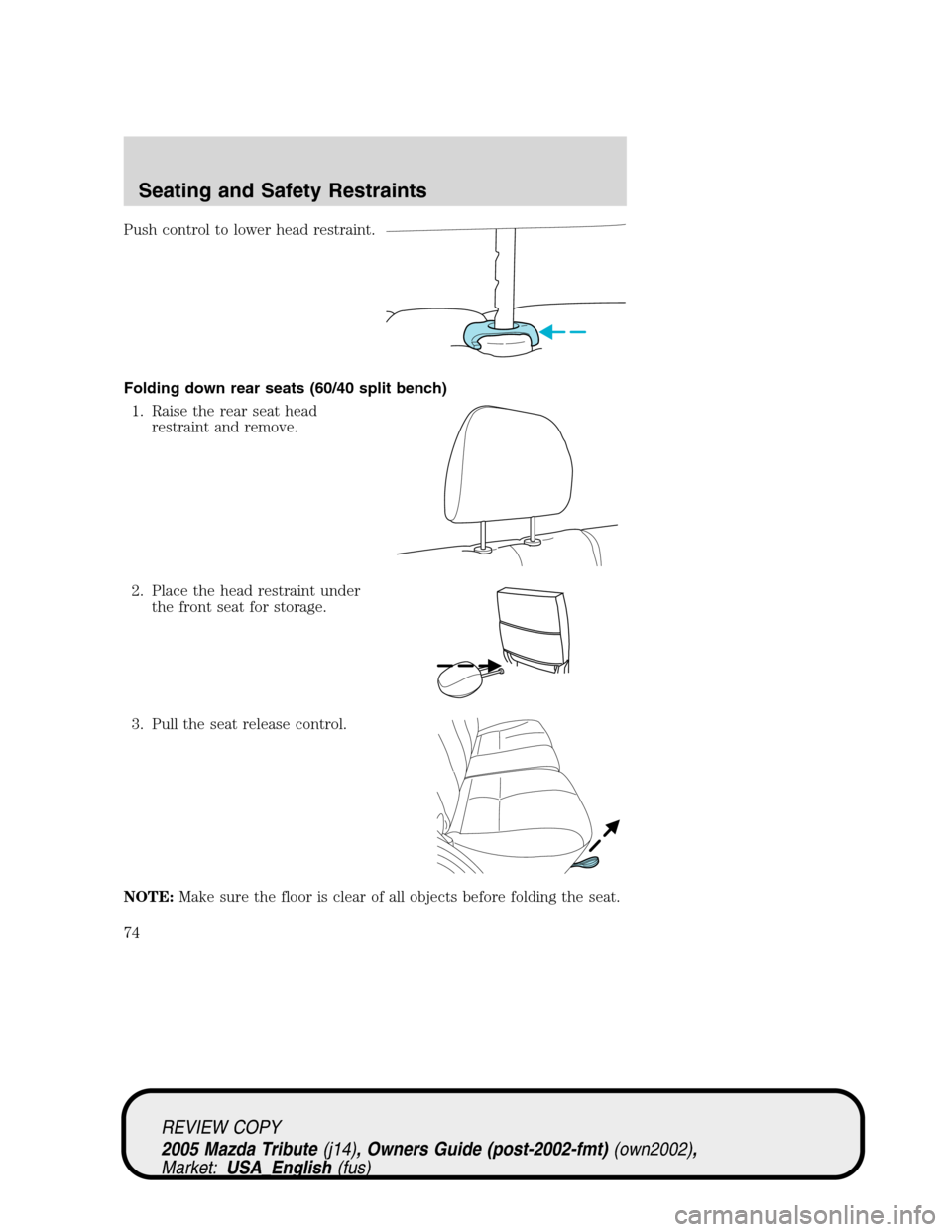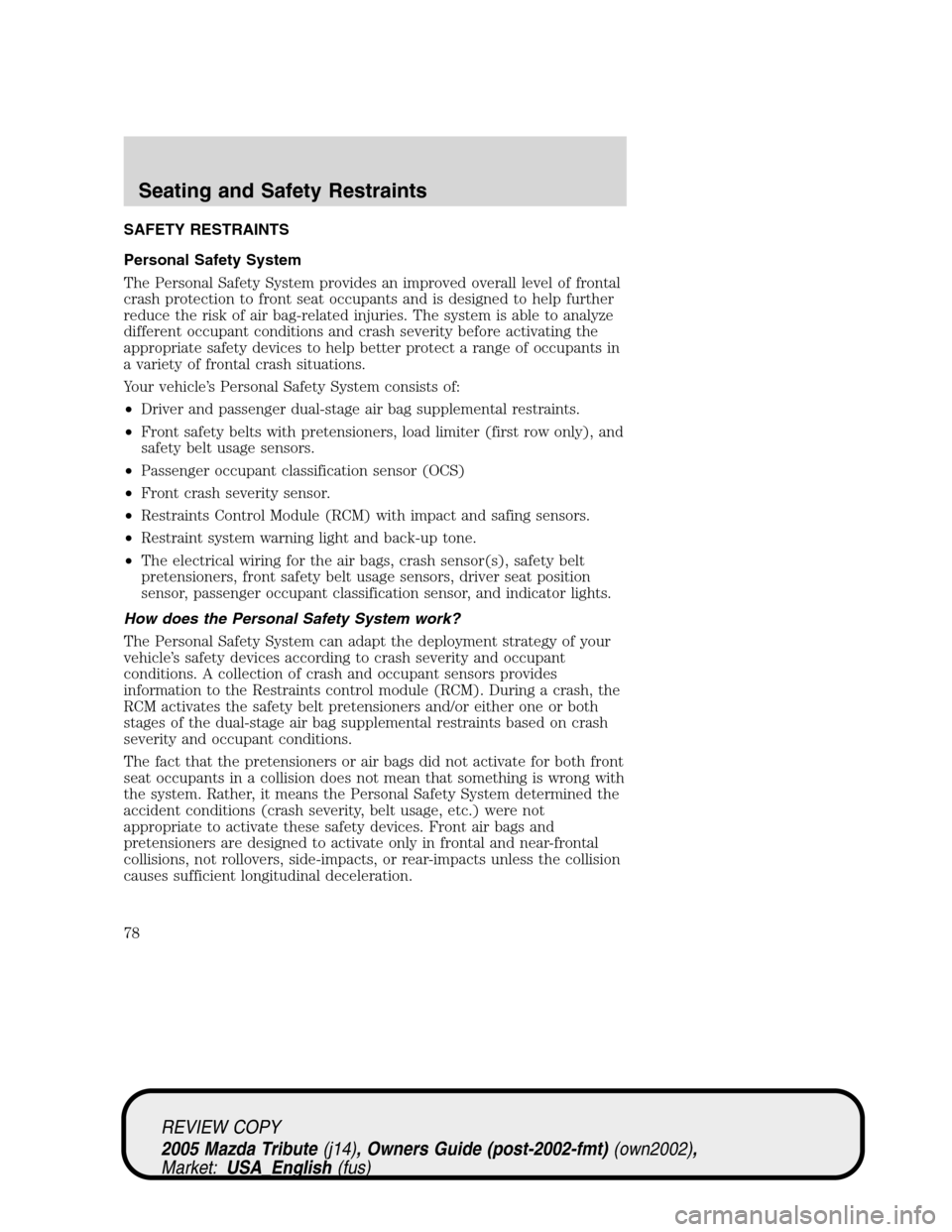MAZDA MODEL TRIBUTE 2005 (in English) Manual PDF
Manufacturer: MAZDA, Model Year: 2005, Model line: MODEL TRIBUTE, Model: MAZDA MODEL TRIBUTE 2005Pages: 272, PDF Size: 2.78 MB
Page 71 of 272

WARNING: Sitting in a reclined position while the vehicle is
moving is dangerous because you don’t get the full protection
from seat belts. During sudden braking or a collision, you can
slide under the lap belt and suffer serious internal injury, or in
a rear end collision you could fly up and out of the vehicle. For
maximum protection, sit well back and upright.
Lift handle to move seat forward or
backward.
Pull lever up to adjust seatback.
Using the manual lumbar support (if equipped)
The lumbar support control is
located on the inboard side of the
driver’s seatback.
Turn the lumbar support control
clockwise to increase firmness.
Turn the lumbar support control
counterclockwise to increase
softness.
REVIEW COPY
2005 Mazda Tribute(j14), Owners Guide (post-2002-fmt)(own2002),
Market:USA_English(fus)
Seating and Safety Restraints
71
Page 72 of 272

Adjusting the front power seat (if equipped)
WARNING: Never adjust the driver’s seat or seatback when the
vehicle is moving. You could move out of position to control the
vehicle. Then a serious accident could occur. Sudden braking or
a collision could cause serious injury. Adjust the seat only when
the vehicle is stopped.
WARNING: Do not pile cargo higher than the seatbacks to
reduce the risk of injuring people in a collision or sudden stop.
WARNING: Always drive and ride with your seatback upright
and the lap belt snug and low across the hips.
WARNING: Sitting in a reclined position while the vehicle is
moving is dangerous because you don’t get the full protection
from seat belts. During sudden braking or a collision, you can
slide under the lap belt and suffer serious internal injury, or in
a rear end collision you could fly up and out of the vehicle. For
maximum protection, sit well back and upright.
The control is located on the outboard side of the seat cushion.
Move the front of the control up or
down to raise or lower the front
portion of the seat cushion.
Move the rear of the control up or
down to raise or lower the rear
portion of the seat cushion.
REVIEW COPY
2005 Mazda Tribute(j14), Owners Guide (post-2002-fmt)(own2002),
Market:USA_English(fus)
Seating and Safety Restraints
72
Page 73 of 272

Move the control in the directions
shown to move the seat forward,
backward, up or down.
Heated seats (if equipped)
To operate the heated seats:
•Push the control located on the
seat to activate.
•Push again to deactivate.
The heated seats will activate when the ignition is in the RUN position.
When activated, they will turn off automatically after 10 minutes or when
the ignition is turned to the OFF position.
REAR SEATS
Head restraints (if equipped)
The purpose of these head restraints is to help limit head motion in the
event of a rear collision. To properly adjust your head restraints, lift the
head restraint so that it is located directly behind your head or as close
to that position as possible.
The head restraints can be moved
up and down.
REVIEW COPY
2005 Mazda Tribute(j14), Owners Guide (post-2002-fmt)(own2002),
Market:USA_English(fus)
Seating and Safety Restraints
73
Page 74 of 272

Push control to lower head restraint.
Folding down rear seats (60/40 split bench)
1. Raise the rear seat head
restraint and remove.
2. Place the head restraint under
the front seat for storage.
3. Pull the seat release control.
NOTE:Make sure the floor is clear of all objects before folding the seat.
REVIEW COPY
2005 Mazda Tribute(j14), Owners Guide (post-2002-fmt)(own2002),
Market:USA_English(fus)
Seating and Safety Restraints
74
Page 75 of 272

4. Flip seat forward.
Attach the seatbelt web snap button
to the quarter trim panel snap
button. This will assure that seatbelt
does not get caught by staying out
of the seat back folding path.
5. To release seatback, pull the
seatback release lever (on top
of seat) toward the front seat.
This is common for both 60%
and 40% seatbacks.
NOTE:When the seatback release
lever is pulled, slowly lower
seatback to the flat position.
REVIEW COPY
2005 Mazda Tribute(j14), Owners Guide (post-2002-fmt)(own2002),
Market:USA_English(fus)
Seating and Safety Restraints
75
Page 76 of 272

6. Rotate seatback down into load
floor position.
Returning the rear seats to upright position
1. Pull seatback up and into
upright position making sure
seatback locks into place.
2. Rotate seat cushion down into
the seating position making sure
that the seat cushion is locked
into place and the RED seat
unlatched indicator on release
paddle is not visible.
REVIEW COPY
2005 Mazda Tribute(j14), Owners Guide (post-2002-fmt)(own2002),
Market:USA_English(fus)
Seating and Safety Restraints
76
Page 77 of 272

WARNING: Make sure seat belt buckle heads are through
elastic holders on seat backs. Seat belt buckle heads may break
if they are trapped underneath the seatback as the seatback is
rotated down.
3. Remove the head restraints
stored under the front
passenger seat and return them
to the original position on the
seat backs.
To remove the rear cushion
1. Lift the yellow tab to release the
hinges.
2. Pull the cushion to the outboard
side of the vehicle.
To install the rear cushion
1. Push the cushion to the inboard
side of the vehicle.
2. Make sure that the hinges are
locked into place.
REVIEW COPY
2005 Mazda Tribute(j14), Owners Guide (post-2002-fmt)(own2002),
Market:USA_English(fus)
Seating and Safety Restraints
77
Page 78 of 272

SAFETY RESTRAINTS
Personal Safety System
The Personal Safety System provides an improved overall level of frontal
crash protection to front seat occupants and is designed to help further
reduce the risk of air bag-related injuries. The system is able to analyze
different occupant conditions and crash severity before activating the
appropriate safety devices to help better protect a range of occupants in
a variety of frontal crash situations.
Your vehicle’s Personal Safety System consists of:
•Driver and passenger dual-stage air bag supplemental restraints.
•Front safety belts with pretensioners, load limiter (first row only), and
safety belt usage sensors.
•Passenger occupant classification sensor (OCS)
•Front crash severity sensor.
•Restraints Control Module (RCM) with impact and safing sensors.
•Restraint system warning light and back-up tone.
•The electrical wiring for the air bags, crash sensor(s), safety belt
pretensioners, front safety belt usage sensors, driver seat position
sensor, passenger occupant classification sensor, and indicator lights.
How does the Personal Safety System work?
The Personal Safety System can adapt the deployment strategy of your
vehicle’s safety devices according to crash severity and occupant
conditions. A collection of crash and occupant sensors provides
information to the Restraints control module (RCM). During a crash, the
RCM activates the safety belt pretensioners and/or either one or both
stages of the dual-stage air bag supplemental restraints based on crash
severity and occupant conditions.
The fact that the pretensioners or air bags did not activate for both front
seat occupants in a collision does not mean that something is wrong with
the system. Rather, it means the Personal Safety System determined the
accident conditions (crash severity, belt usage, etc.) were not
appropriate to activate these safety devices. Front air bags and
pretensioners are designed to activate only in frontal and near-frontal
collisions, not rollovers, side-impacts, or rear-impacts unless the collision
causes sufficient longitudinal deceleration.
REVIEW COPY
2005 Mazda Tribute(j14), Owners Guide (post-2002-fmt)(own2002),
Market:USA_English(fus)
Seating and Safety Restraints
78
Page 79 of 272

Driver and passenger dual-stage air bag supplemental restraints
The dual-stage air bags offer the capability to tailor the level of air bag
inflation energy. A lower, less forceful energy level is provided for more
common, moderate-severity impacts. A higher energy level is used for
the most severe impacts. Refer toAir bag supplemental restraints
section in this chapter.
Front crash severity sensor
The front crash severity sensor enhances the ability to detect the
severity of an impact. Positioned up front, it provides valuable
information early in the crash event on the severity of the impact. This
allows your Personal Safety System to distinguish between different
levels of crash severity and modify the deployment strategy of the
dual-stage air bags and safety belt pretensioners.
Driver’s seat position sensor
The driver’s seat position sensor allows your Personal Safety System to
tailor the deployment level of the driver dual-stage air bag based on seat
position. The system is designed to help protect smaller drivers sitting
close to the driver air bag by providing a lower air bag output level.
Occupant Classification Sensor (OCS)
For air bags to do their job they must inflate with great force, and this
force can pose a potentially deadly risk to occupants that are very close
to the air bag when it begins to inflate. For some occupants, like infants
in rear-facing child seats, this occurs because they are initially sitting
very close to the air bag. For other occupants, this occurs when the
occupant is not properly restrained by seat belts or child safety seats and
they move forward during pre-crash braking. The most effective way to
reduce the risk of unnecessary injuries is to make sure all occupants are
properly restrained. Accident statistics suggest that children are much
safer when properly restrained in the rear seating positions than in the
front.
WARNING: Air bags can kill or injure a child in a child seat.
NEVER place a rear-facing child seat in front of an active air
bag. If you must use a forward-facing child seat in the front
seat, move the seat all the way back.
WARNING: Always transport children 12 years old and under
in the back seat and always properly use appropriate child
restraints.
REVIEW COPY
2005 Mazda Tribute(j14), Owners Guide (post-2002-fmt)(own2002),
Market:USA_English(fus)
Seating and Safety Restraints
79
Page 80 of 272

The front passenger sensing system can automatically turn off the
passenger front air bag. The system is designed to help protect small
(child size) occupants from air bag deployments when they are
improperly seated or restrained in the front passenger seat contrary to
proper child-seating or restraint usage recommendations. Even with this
technology, parents areSTRONGLYencouraged to always properly
restrain children in the rear seat. The sensor also turns off the passenger
front air bag and seat-mounted side air bag (if equipped) when the
passenger seat is empty to prevent unnecessary replacement of air
bag(s) after a collision.
When the front passenger seat is occupied and the sensing system has
turned off the passenger’s frontal air bag, the“pass air bag off”indicator
will light and stay lit to remind you that the front passenger frontal air
bag is off. SeeFront passenger sensing systemin the airbags section of
this chapter.
Front safety belt usage sensors
The front safety belt usage sensors detect whether or not the driver and
front outboard passenger safety belts are fastened. This information
allows your Personal Safety System to tailor the air bag deployment and
safety belt pretensioner activation depending upon safety belt usage.
Refer toSafety beltsection in this chapter.
Front safety belt pretensioners
The safety belt pretensioners at the front outboard seating positions are
designed to tighten the safety belts firmly against the occupant’s body
during a frontal or near-frontal collision. This maximizes the effectiveness
of the safety belts and helps properly position the occupant relative to
the air bag to improve protection. The safety belt pretensioners can be
either activated alone or, if the collision is of sufficient severity, together
with the air bags.
Front safety belt load limiter
The front outboard safety belt load limiter allows webbing to be pulled
out of the retractor in a gradual and controlled manner in response to
the occupant’s forward momentum. This helps reduce the risk of
force-related injuries to the occupant’s chest by limiting the load on the
occupant. Refer toLoad limiter featuresection in this chapter.
REVIEW COPY
2005 Mazda Tribute(j14), Owners Guide (post-2002-fmt)(own2002),
Market:USA_English(fus)
Seating and Safety Restraints
80